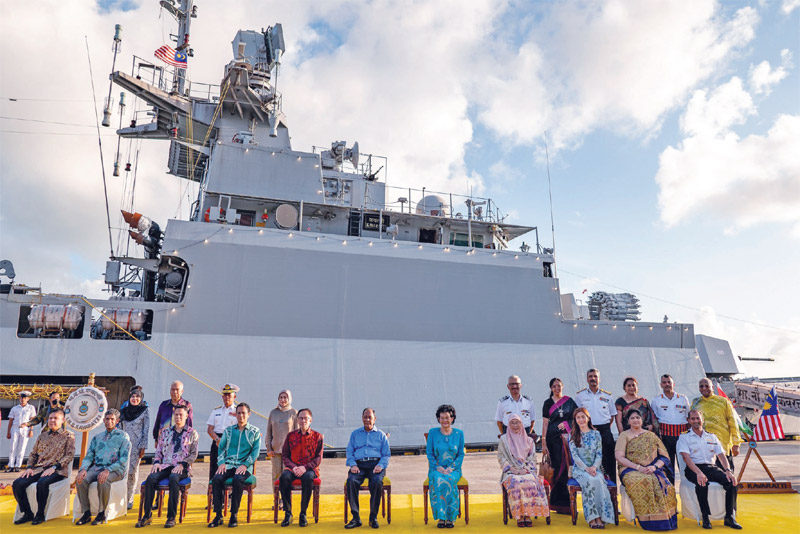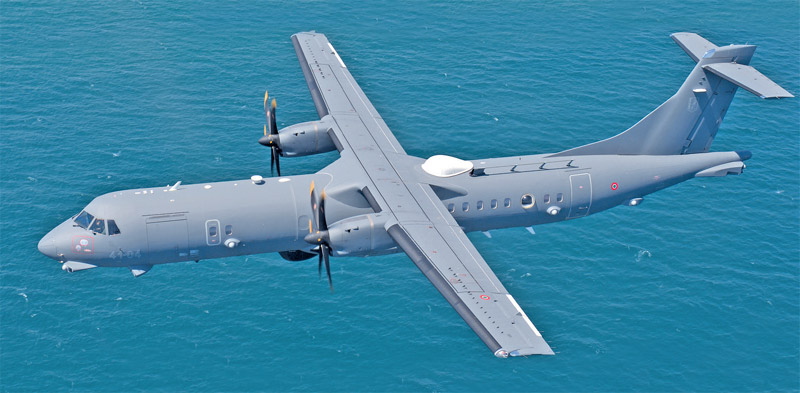Malaysia, Indonesia among countries moving away from Russian-origin weapon systems
Prasun K. Sengupta
The 16th edition of Malaysia’s biennial Langkawi International Maritime and Aerospace Exhibition–LIMA 2023—was held from May 23 to 27 at the Mahsuri International Exhibition Centre (MIEC), which is co-located with the Langkawi international airport, while the maritime segment of the expo was held at the Resorts World Langkawi (formerly known as Awana Porto Malai), some 12 km away from the MIEC.

Altogether 600 local and foreign exhibitors were present at the expo from countries that included (apart from the host country) Türkiye, the United States, China, United Kingdom, France, United Arab Emirates (UAE), Indonesia, Thailand, Italy, Brazil, Germany, Singapore, South Korea, Pakistan, India, Bangladesh, Saudi Arabia, Belgium and the Czech Republic. The biggest pavilions were from Türkiye and UAE companies.
The impressions emerging from this expo were that countries like Malaysia and Indonesia, which had procured Russia-origin weapons and platforms since the early 1990s, are in no mood to procure any such systems from Moscow. Instead, original equipment manufacturers (OEM) from the US, Europe, Scandinavia, South Korea and Türkiye would be given preference. While Türkiye has made significant inroads into both Indonesia and Malaysia, Israeli OEMs are dominating the market in the Philippines. Russian OEMs continue to dominate the markets in Myanmar and Vietnam, China dominates in Cambodia, Laos and Thailand. The US and Israel remain dominant in Singapore, while in Malaysia, France has replaced the UK as the major supplier of equipment like air-defence radars, warships, submarines and military helicopters.
The contract signing ceremony for the sale of 18 FA-50 tandem-seat advanced trainers/ light fighters worth USD 920 million to the Royal Malaysian Air Force (RMAF) took place on May 23. In February this year, South Korea’s Korea Aerospace Industries (KAI) had inked a Letter of Acceptance with Malaysia’s Ministry of Defence (MINDEF) for the Light Combat Aircraft/Fighter Lead-In Trainer (LCA/FLIT) requirement and for the past three months was discussing details such as aircraft delivery times and follow-up logistics support.
It was in November 2022 that the KAI had won the LCA/FLIT competition, ending the Hindustan Aeronautics Limited’s (HAL) bid to supply the Tejas Mk.1 (FORCE, October 2022). Eight FA-50s will be configured primarily as lead-in fighter trainers (LIFT) while the remaining 10 would be light multi-role combat aircraft (L-MRCA). The LIFTs will replace the RMAF’s seven Aermacchi MB-339CMs, which are currently grounded. The L-MRCAs will replace the 18 BAE Systems Hawk Mk.108 two-seat (trainer and attack) and Mk.208 single-seat light attack aircraft. The LCA/FLIT project is part of the RMAF’s ‘Capability 55’ plan. Launched in 2018, it stipulates the acquisition of 36 new LCA/ LIFT platforms in two phases with 18 aircraft to be purchased from 2021 and the remainder from 2025. The 36 aircraft are intended to equip one LIFT squadron and two L-MRCA squadrons.
Over the past decade, the FA-50 has scored several notable marketing successes, starting with the TA-50 light attack variant being ordered by Indonesia in 2011, with 16 of them entering service by 2014 while an additional six were ordered in 2021. Iraq ordered 24 of them in the T-50IQ variant in 2013, and received them in 2016. The Philippines ordered 12 FA-50 light fighter variants in 2014, which delivered over the next few years, and the country is now considering ordering another batch of 12 aircraft. Thailand ordered 12 T-50TH variants in 2015 and last year Poland ordered 48 FA-50s. Egypt is expected to be the next customer, which will mean that the Tejas Mk.1 has suffered defeat against the FA-50.

It was revealed at the expo that a Lockheed Martin TPS-77 L-band long-range airspace surveillance radar will be commissioned on the island of Labuan in the South China Sea by the year’s end, replacing a GEC-Marconi S-743D L-band Martello radar (two of which were acquired between 1992 and 1995) and has already been decommissioned. The TPS-77 will be located at Bukit Kubong, Labuan, and will be operated by the RMAF’s 340 Squadron. The TPS-77 will function in conjunction with the 331 Squadron-operated and ThalesRaytheon-supplied Ground Master GM-406A S-band radar (acquired in 2013) on Gunung Ngili in Kota Samarahan, Sarawak State. It was in April 2008 that Malaysia contracted the Franco-American joint venture ThalesRaytheon Systems a contract of for the RMAF’s Malaysian Air Defence Ground Environment Sector Operations Centre-III (MADGE SOC-III). The system uses the Sentry C2 (Command and Control) software. The MADGE SOC-III forms a radar acquisition picture using the GroundMaster-406A 470km-range radar. The MADGE SOC-III network also employs two Leonardo/Selex RAT-31SL S-band 134km-range radars, acquired between 1996 and 1998, along with a single RAT-31DL L-band 500km-range radar that was acquired in 2003.
The MINDEF, which last October had announced plans to buy three Anka-S MALE-UAVs from Turkiye’s Tusas Aerospace Industries (TAI), inked the procurement contract worth USD 91.6 million on May 25 at the expo. Another six of these UAVs will be procured in two successive tranches of three each in future. The Anka-S has a wingspan of 17.5 metres, a length of 8.6 metres and has a service ceiling of 30,000 feet. It can remain airborne at the operational altitude of 23,000 feet for more than 30 hours. The Anka-S boasts a data link range of 250 km and can be armed with a variety of precision-guided bombs and missiles developed in Turkiye, including the MAM series of laser-guided bombs that have seen combat in Libya, Syria, Nagorno-Karabakh and Ukraine.
This is the second export success for Turkiye in Malaysia with the first in 2011 when FNSS Savunma Sistemleri AŞ and its Malaysian business partner DRB Hicom Defence Technologies Sdn Bhd. (DEFTECH) secured the contract to supply 257 8 x 8 AV-8 ‘Pars’ armoured vehicles in 12 different configurations for meeting the needs of the Malaysian Army. The variant with a 25mm Sharpshooter one-man turret is called the Gempita (Thunder). FNSS is now offering its 4×4 and 6×6 armoured vehicles to replace the Malaysian Army’s Germany-made Condor 4×4s and Belgium-made Sibmas 6×6 armoured vehicles.
At the expo, MINDEF inked a contract with Italy’s Leonardo Group for procuring two ATR-72MP twin-turboprop maritime patrol aircraft, whose selection had been announced last October. The ATR-72MP has been optimised for carrying out missions that include maritime surveillance, anti-submarine warfare, anti-surface unit warfare (AsuW), search and rescue (SAR), environmental monitoring, medical evacuation and transport of personnel and materials. The core of the ATR 72MP mission management suite is its modular Airborne Tactical Observation and Surveillance (ATOS) mission system. The main sensor installed on the ATR-72MP is Leonardo Electronics’ Seaspray-7300E active electronically scanned array (AESA) multimode radar.
India’s state-owned HAL brought an example of its Light Utility Helicopter (LUH) to the MIEC, marking the first time that this particular helicopter-type has travelled overseas. The original intention was to fly the 3-tonne-class LUH to Malaysia, but in the end it was ferried by an Indian Air Force C-17A Globemaster-II airlifter due to logistics considerations. The helicopter on static display was a limited series production example, one of 12 such LUHs being produced by 2024. The first was rolled out last February and the Indian Army and Indian Air Force will receive six each later this year.

Regional developments
In Southeast, Thailand continues to remain the largest export market for China’s weapons manufacturers. The Royal Thai Navy (RTN) recently unveiled the FK-3 air-defence system, manufactured by the China Aerospace Science & Industry Corp Ltd (CASIC). The FK-3 is the export variant of the CASIC’s HQ-22 long-range semi-active radar homing/ radio-command guidance air-defence system.
It retains the HQ-22’s top speed of Mach 6, although its maximum range of 100km is significantly shorter than the HQ-22’s 170km-range. The FK-3 was inducted into the RTN in 2022 and serves as an offensive combat missile and an air-defence shield. A FK-3 unit has six to eight mobile transporter erector launchers (TEL), each carrying four launch tubes. The system achieves cost savings by relying on a less-expensive semi-active guidance system that can switch to full radio-command guidance in the event of strong electronic interference.
The Royal Thai Army (RTA), on the other hand, has procured the KS-1C 70km-range surface-to-air missile (SAM) system between 2016 and 2018. The KS-1C too was developed by CASIC. The KS-1Cs are fired from twin launch-rails mounted on a 6 x 6 truck. The SAM system is paired with the HT-233 passive phased-array engagement radar, which has detection range of up to 120 km. The HT-233 radar can direct six KS-1C missiles to intercept three to six incoming targets. Unlike the Western-leaning Royal Thai Air Force (RTAF), the RTA has adopted various China-origin equipment, including the 302mm WS-1 multiple rocket launcher and the VT-4/MBT-3000 main battle tank (MBT). The RTA has already service-inducted 38 VT-4 MBTs. The RTA had ordered 28 VT-4s from China North Industries Corp (NORINCO) in 2016 for Baht5 billion and another 10 in 2017 for Baht2 billion. The RTA wants to procure an additional 100 VBT-4s to replace ageing and depleted inventories of US-produced M41 light tanks. The VT-4s were acquired at one-third the cost of similar sales proposals from Western MBT manufacturers.
The RTN commissioned its Type 071E landing platform dock (LPD), HTMS Chang (792), on April 25 this year in Chuk Samet Port, Sattahip Naval Base. Thailand had signed a USD 200 million contract with the China State Shipbuilding Corporation (CSSC) for the procurement of this LPD on 9 September 2019. HTMS Chang was launched in December 2021 and completed its sea trials in December 2022. However, the RTN’s plans to procure three 2,600 tonne S-26T Yuan-class submarines from China Shipbuilding Industry Corp (CSIC) has run into rough weather. In 2017, Thailand agreed to pay USD 395 million for the procurement of its first S-26T. Steel-cutting of this boat took place in September 2018 at the Wuhan-based Wuchang Shipbuilding Industry Group Co, while the keel-laying took place on 5 September 2019.
China agreed to a payment scheme in 17 instalments, reducing the financial pressure for the Thai annual budgets. At that time, the RTN had indicated that the S-26T’s key strengths were: the reliability of its Stirling Engine-based air-independent propulsion (AIP) system, which has already proven itself on board ten PLA Navy submarines (Type-039A and Type-039B) and was providing a submerge endurance of 21 days; the wide range of weapon systems, such as torpedoes, mines, anti-ship and land attack missiles that the S-26t could make use of; the availability of rescue capsules (bells) and the favourable reserve buoyancy margins of the design; offer of a two-year warranty, something that the other five competing submarine manufacturers reportedly could not match; guaranteeing the availability of spare parts for eight years, and offering five complete ship diagnostics (inclusive of refits) as part of the deal.
In the contract, the RTN had specified that its S-26Ts be powered by MTU-supplied Series-396 diesel engines. However, subsequently it emerged that Germany refused to export these engines to China for fitment on to the S-26Ts due to a European Union-imposed embargo on the sale of such equipment to China. As a result, construction of the first S-26T has been suspended since early 2022, and it will take more than three years to finish the S-26T’s construction if and when the question of its propulsion system is settled. China has since proposed that its CHD-620 diesel engine, built by the state-owned China Shipbuilding & Offshore International Co (CSOC), be considered as the replacement. The RTN now has three conditions to consider: the engine must be safe; the PLA Navy must give performance guarantees for this engine; there must be financial compensation for the delay due to the engine change.

